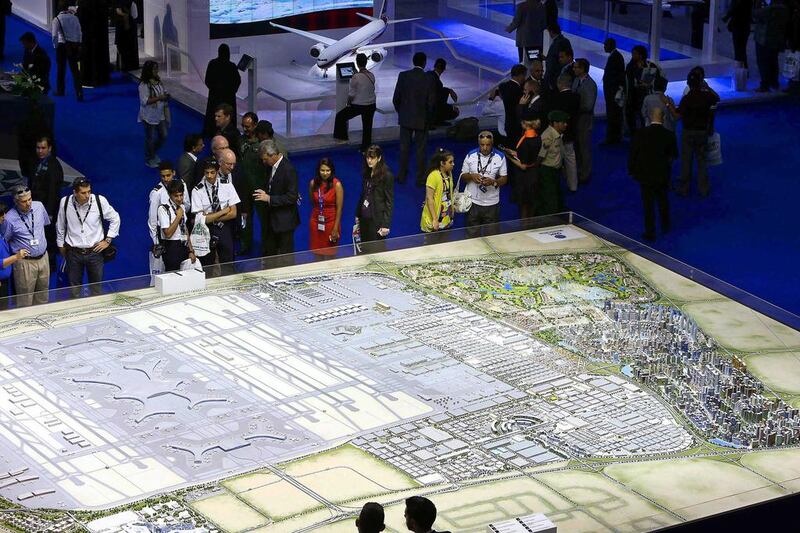In September 2014, Sheikh Mohammed bin Rashid, Vice President of the UAE and Ruler of Dubai, approved plans to launch a US$32 billion expansion of Al Maktoum International Airport at Dubai World Central, paving the way for what had been announced as the biggest airport project in the world.
It opened for passenger operations in October 2013 and can accommodate 5 million travellers per year. The first phase of the expansion will involve the construction of two satellite buildings which will increase capacity to about 120 million passengers per year.
In the second phase, two new runways and storage hangars will be added. The plan is to complete phase two to coincide with the start of Expo 2020 in Dubai.
In the third and final phase, the airport plans to boast five parallel runways, which can be operated simultaneously, and to have enough gates and storage hangars to house 100 double-decker Airbus 380 planes at a time. The final annual capacity of the new airport is projected to be about 220 million passengers.
These are exciting plans and they serve as a good barometer of the upturn in confidence in the emirate and the wider region. However, it is worth considering if there should be a pause to reflect on whether the Arabian Gulf region is heading towards airport overcapacity.
Dubai International Airport, Dubai’s other international passenger airport, currently has a capacity of about 80 million passengers a year, which will increase to approximately 90 million once the new concourse D opens in the second half of this year. Abu Dhabi’s main airport has 12.5 million annual capacity, and is projected to experience a 70 per cent rise in passenger numbers by 2017. And more than 8 million passengers a year are using the airport in Sharjah.
In addition, the new Hamad International Airport in Doha has an annual capacity of about 30 million passengers, which will increase to 50 million at full capacity – and there are plans to expand it further. Oman also intends to increase its capacity to up to 48 million passengers per year. Kuwait and Bahrain are planning for a 13 million and 15 million annual passenger capacity respectively, and Saudi Arabia is proposing to increase its capacity in the coming years to 40 million. The combined capacity if all projects are fully completed will be in the region of a quarter of a billion passengers per year.
To put it in context, that is more than the joint capacity of the world’s top three largest airports by passenger numbers last year. The top three in capacity are Hartsfield-Jackson Atlanta – 96.17 million passengers a year; Beijing Capital – 86.13 million, and London Heathrow – 73.4 million.
The Dubai Airports chief executive, Paul Griffiths, believes that the new airport expansion is necessary and has said that the new airport will "not only create the capacity we need in the coming decades but also provide state-of-the-art facilities that revolutionise the airport experience on an unprecedented scale".
The numbers appear to back up his view, with Dubai International increasing its passenger numbers at an average of 15 per cent year on year and in the first quarter of last year passed Heathrow in terms of annual numbers of international passengers.
The current Dubai International Airport will eventually run out of passenger capacity with the consequence that Dubai needs to expand its current aviation capabilities to enable its further growth. The benefits of developing another aviation hub include the projected creation of more than 20,000 new jobs in the construction sector and the generation of supporting infrastructure such as new hotels, housing and transport. The new airport could prove to be a catalyst for growth and keep Dubai one step ahead of the competition.
Dubai’s establishment as an aviation hub has been a significant contributor to the emirate’s growth and so far the maxim “build it and they will come” seems to have been borne out. While this optimism is positive, one needs to pause and consider lessons that can be learnt from the past. Dubai’s growth, before the global recession in 2008 was phenomenal, but when the financial crisis came it was left exposed, overleveraged and in deep recession. The risk is therefore that the new airport, when considered in the context of the existing and proposed passenger capacity levels across the Arabian Gulf, may not deliver the returns on the huge investment required.
The answer may lie in the sensible, phased development of the new Al Maktoum airport so that plans can be readjusted along the way if required. Airport development is for the long term. Forward planning is important both in terms of anticipating capacity and ensuring that facilities are up to date and able to cater for advances in aircraft and air travel more generally. If the current optimism and growth continues towards and post Expo 2020, and the passengers keep coming, it seems that Dubai will enjoy the rewards of its plans both in terms of airports and related infrastructure.
Bjorn Gehle is a partner and Katy Hacking is a solicitor in the Dubai office of the law firm Pinsent Masons.
Follow The National's Business section on Twitter





